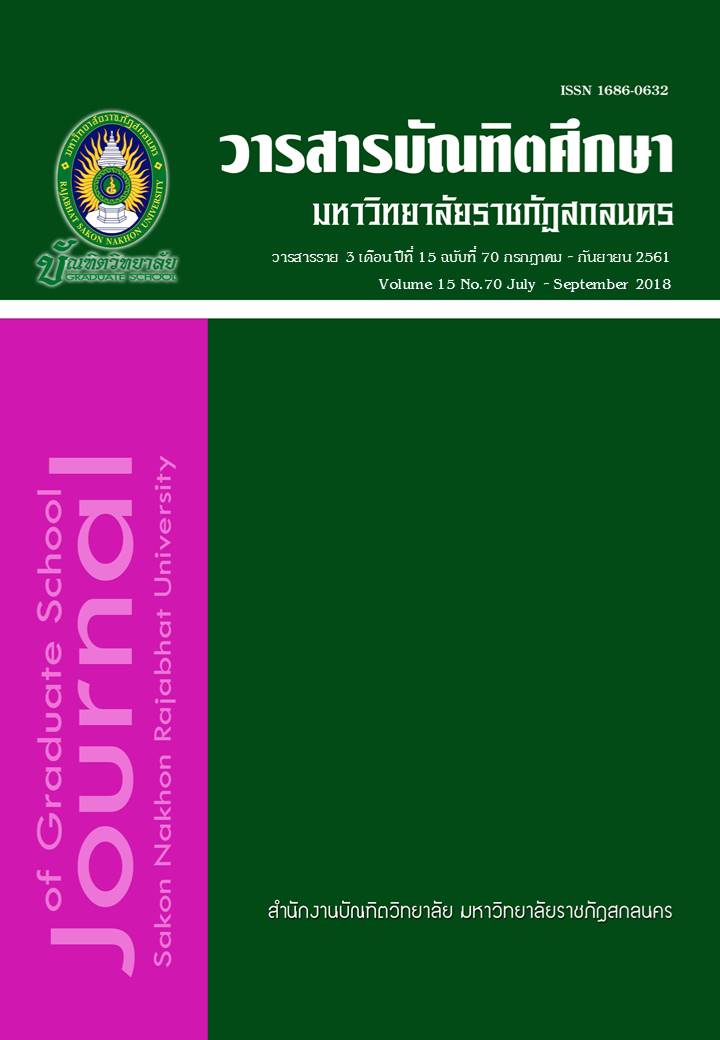การพัฒนาระบบการกำกับติดตามและประเมินแบบเสริมสร้างพลังอำนาจในการจัดการเรียนรู้ของครู สังกัดองค์กรปกครองส่วนท้องถิ่น
Main Article Content
Abstract
บทคัดย่อ
การศึกษาครั้งนี้เป็นการวิจัยและพัฒนา มีวัตถุประสงค์ 1) เพื่อสังเคราะห์ระบบการกำกับติดตามและประเมินแบบเสริมสร้างพลังอำนาจในการจัดการเรียนรู้ของครู 2) เพื่อพัฒนาและตรวจสอบระบบ 3) เพื่อทดลองและศึกษาผลการใช้ระบบ และ 4) เพื่อประเมินประสิทธิผลของระบบ การวิจัยแบ่งเป็น 4 ขั้นตอน ประกอบด้วยขั้นตอนที่ 1 การสังเคราะห์องค์ประกอบของระบบ ด้วยการสังเคราะห์เอกสารและงานวิจัยที่เกี่ยวข้อง ขั้นตอนที่ 2 การพัฒนาและตรวจสอบระบบ โดยผู้ตรวจสอบระบบ คือ ผู้เชี่ยวชาญ ขั้นตอนที่ 3 การทดลองและศึกษาผลการใช้ระบบ ตัวอย่างที่ใช้ในการศึกษา คือ ผู้บริหารสถานศึกษา และครู จาก 3 โรงเรียน 3 ขนาดคือ ขนาดเล็ก ขนาดกลาง และขนาดใหญ่ ได้มาโดยการสุ่มแบบหลายขั้นตอน เครื่องมือที่ใช้ในการวิจัย ประกอบด้วย 1) แบบวัดความรู้ความเข้าใจการกำกับติดตามและประเมินแบบเสริมสร้างพลังอำนาจ 2) แบบวัดความรู้ความเข้าใจการจัดการเรียนรู้ที่เน้นผู้เรียนเป็นสำคัญ 3) แบบกำกับติดตามและประเมินผลการจัดการเรียนรู้ 4) แบบวัดเจตคติที่มีต่อการกำกับติดตามและประเมินแบบเสริมสร้างพลังอำนาจในการจัดการเรียนรู้ของครู ค่าความเชื่อมั่นของเครื่องมือวิจัย อยู่ระหว่าง .81 ถึง .96 สถิติที่ใช้ในการวิจัย คือ ค่าเฉลี่ย ส่วนเบี่ยงเบนมาตรฐาน และการทดสอบค่าที ขั้นตอนที่ 4 การประเมินประสิทธิผลระบบ ตัวอย่างที่ใช้ คือ ตัวอย่างที่ทดลองใช้ระบบในขั้นตอนที่ 3 เครื่องมือที่ใช้ในการวิจัย คือ แบบประเมินประสิทธิผลของระบบสถิติที่ใช้ในการวิจัย คือ ค่าเฉลี่ย ส่วนเบี่ยงเบนมาตรฐาน
ผลการวิจัยพบว่า
1. องค์ประกอบของระบบการกับกำกับติดตามและประเมินแบบเสริมสร้างพลังอำนาจในการจัดการเรียนรู้ของครู ประกอบด้วย 4 องค์ประกอบ คือ 1) ด้านปัจจัยนำเข้า ประกอบด้วย ผู้บริหารสถานศึกษา ครู หลักสูตรสถานศึกษา และแผนการจัดการเรียนรู้ 2) ด้านกระบวนการ ซึ่งบูรณาการจาก หลักการบริหารงานคุณภาพแบบ PDCA ขั้นตอนการประเมินแบบเสริมสร้างพลังอำนาจ และ ลักษณะของการประเมินแบบเสริมสร้างพลังอำนาจ ทำให้ได้องค์ประกอบใหม่ของกระบวนการ ประกอบด้วย 4 ขั้นตอน คือ ขั้นตอนที่ 1 ร่วมวางแผนจัดเตรียมความพร้อม ขั้นตอนที่ 2 น้อมนำสู่การปฏิบัติ ขั้นตอนที่ 3 ประเมินตัดสินความก้าวหน้า ขั้นตอนที่ 4 กำหนดทิศทางพัฒนาร่วมกัน และ 3) ด้านผลผลิต ได้แก่ (1) ผู้บริหารสถานศึกษาและครูมีความรู้ความเข้าใจการกำกับติดตามและ
ประเมินผลแบบเสริมสร้างพลังอำนาจ (2) ผู้บริหารสถานศึกษาและครู มีความรู้ความเข้าใจการจัดการเรียนรู้
* นักศึกษาหลักสูตรปรัชญาดุษฎีบัณฑิต สาขาวิชาวิจัยและประเมินผลการศึกษา มหาวิทยาลัยราชภัฏอุบลราชธานี
** อาจารย์ประจำหลักสูตร สาขาวิชาวิจัยและประเมินผลการศึกษา มหาวิทยาลัยราชภัฏอุบลราชธานี
*** อาจารย์ประจำหลักสูตร สาขาวิชาการบริหารการศึกษา มหาวิทยาลัยราชภัฏอุบลราชธานี
ที่เน้นผู้เรียนเป็นสำคัญ (3) ผู้บริหารสถานศึกษาและครู มีเจตคติที่ดีต่อการกำกับติดตามและประเมินแบบเสริมสร้างพลังอำนาจ และ 4) ด้านข้อมูลป้อนกลับ
2. ระบบที่พัฒนาขึ้น เป็นระบบที่เน้นกระบวนการ ซึ่งกระบวนการ ประกอบด้วย 4 ขั้นตอน คือ ขั้นตอนที่ 1 ร่วมวางแผนจัดเตรียมความพร้อม ขั้นตอนที่ 2 น้อมนำสู่การปฏิบัติ ขั้นตอนที่ 3 ประเมินตัดสินความก้าวหน้า ขั้นตอนที่ 4 กำหนดทิศทางพัฒนาร่วมกัน ผลการประเมินระบบและคู่มือการใช้ระบบโดยภาพรวมมีความเหมาะสมและมีความเป็นไปได้อยู่ในระดับมากที่สุด
3. ผลการทดลองใช้ระบบ ผู้บริหารสถานศึกษาและครู มีความรู้ความเข้าใจเกี่ยวกับการกำกับติดตามและประเมินแบบเสริมสร้างพลังอำนาจ ผู้บริหารสถานศึกษาและครู มีความรู้ความเข้าใจเกี่ยวกับการจัดการเรียนรู้ที่เน้นผู้เรียนเป็นสำคัญ หลังจากการใช้ระบบสูงกว่าก่อนการใช้ระบบอย่างมีนัยสำคัญทางสถิติที่ระดับ .01 และผู้บริหารสถานศึกษาและครู มีเจตคติที่ดีต่อระบบการกำกับติดตามและประเมินแบบเสริมสร้างพลังอำนาจในการจัดการเรียนรู้ของครูภาพรวมอยู่ในระดับมาก
4. การประเมินประสิทธิผลของระบบการกำกับติดตามและประเมินแบบเสริมสร้างพลังอำนาจในการจัดการเรียนรู้ของครู พบว่ามีประสิทธิผลโดยรวมอยู่ในระดับมาก
ABSTRACT
This study is the research and development; the purposes were 1) to synthesize the monitor and empowerment evaluation system in the Instruction of Teachers 2) to develop and investigate the system 3) to experimental and study the result of system usage and 4) to evaluate the effectiveness of the system. This research is divided into four steps which consist of: The first step is the synthesis of system element by synthesizing documents and related research. The second step is the development and system investigation by the experts. The third step is the experiment and studies the result of system usage. The samples consisted of school administrators and teachers from three schools depending on school size; the small school, middle school and large school by multi stage sampling. The research instruments were 1) cognitive measurement model of the monitor and empowerment evaluation system. 2) the cognitive-based learning management model for the learner centered approach 3) the tracking model and evaluation of learning management. 4) the attitude measurement on the monitor and empowerment evaluation system in the Instruction of teachers. Reliability of the instrument is in between .81 to .96. The data was analyzed using by mean, standard deviation, and samples t-test. The fourth stage is the evaluation of effectiveness system. The sample was the experimental sample in the third stage. The research instrument was the evaluation form of system. The statistics of this research were mean and standard deviation.
The results of the study were as follow:
1. The element of the monitor and empowerment evaluation system in the Instruction of teachers were consisted of four elements. 1) Input was included the administrators, teachers, school curriculum and lesson plan. 2) Process was included the step of quality management of PDCA. The step of empowerment evaluation system and characteristic of empowerment evaluation system make a new element of process which included four steps; the first step is to plan and to prepare. The second step is ready to act. The third step is to evaluate and judge the advancement. The fourth step is to indicate the direction of development together. 3) Productions were 1) school administrators and teachers understand the monitor and empowerment evaluation system. 2) School administrators and teachers understand the learner centered approach. 3) School administrators and teachers have a good attitude in monitor and empowerment evaluation system and 4) feedback.
2. The system was emphasized processes which were depended on four steps; 1) planning and preparing 2) acting 3) evaluating the advance 4) determining the aspect in development. The result of the system and hand book of system was suitable and the possibility was in the highest level.
3. The result of experimental system found that school administrators and teachers understand about the monitor and evaluation empowerment system. School administrators and teachers understand about the learner centered approach after using the system which was higher than before using and statistically significant at .01 level. School administrators and teachers have a good attitude of monitor and empowerment evaluation system at a high level.
4. The result of effectiveness of the monitoring and empowerment evaluation system in the Instruction of teachers at a high level.
Article Details
บทความทุกบทความที่ตีพิมพ์ในวารสารบัณฑิตศึกษา มหาวิทยาลัยราชภัฏสกลนคร ถือว่าเป็นลิขสิทธิ์ของบัณฑิตวิทยาลัย มหาวิทยาลัยราชภัฏสกลนคร
